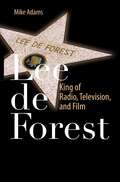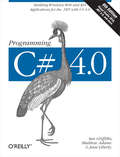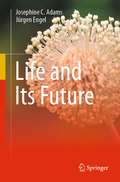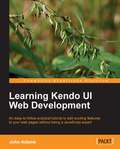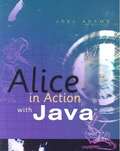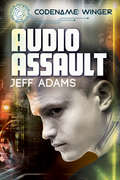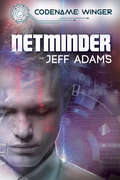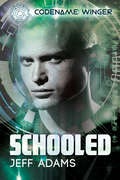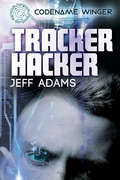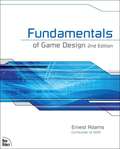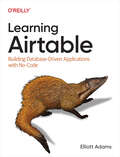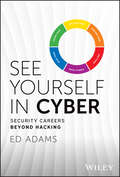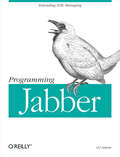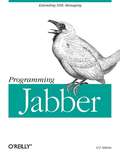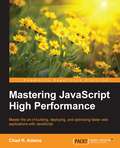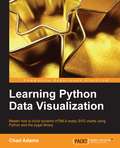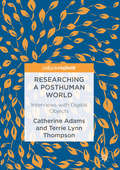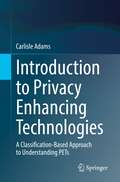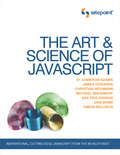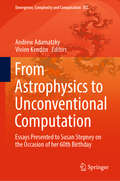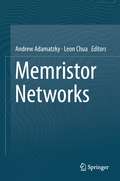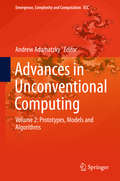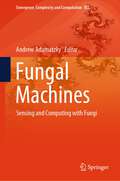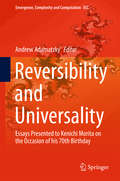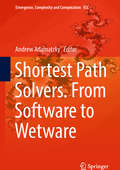- Table View
- List View
Lee de Forest
by Mike AdamsThe life-long inventor, Lee de Forest invented the three-element vacuum tube used between 1906 and 1916 as a detector, amplifier, and oscillator of radio waves. Beginning in 1918 he began to develop a light valve, a device for writing and reading sound using light patterns. While he received many patents for his process, he was initially ignored by the film industry. In order to promote and demonstrate his process he made several hundred sound short films, he rented space for their showing; he sold the tickets and did the publicity to gain audiences for his invention. Lee de Forest officially brought sound to film in 1919. Lee De Forest: King of Radio, Television, and Film is about both invention and early film making; de Forest as the scientist and producer, director, and writer of the content. This book tells the story of de Forest's contribution in changing the history of film through the incorporation of sound. The text includes primary source historical material, U.S. patents and richly-illustrated photos of Lee de Forest's experiments. Readers will greatly benefit from an understanding of the transition from silent to audio motion pictures, the impact this had on the scientific community and the popular culture, as well as the economics of the entertainment industry.
Programming C# 4.0: Building Windows, Web, and RIA Applications for the .NET 4.0 Framework (Animal Guide)
by Matthew Adams Jesse Liberty Ian GriffithsWith its support for dynamic programming, C# 4.0 continues to evolve as a versatile language on its own. But when C# is used with .NET Framework 4, the combination is incredibly powerful. This bestselling tutorial shows you how to build web, desktop, and rich Internet applications using C# 4.0 with .NET's database capabilities, UI framework (WPF), extensive communication services (WCF), and more. In this sixth edition, .NET experts Ian Griffiths, Matthew Adams, and Jesse Liberty cover the latest enhancements to C#, as well as the fundamentals of both the language and framework. You'll learn concurrent programming with C# 4.0, and how to use .NET tools such as the Entity Framework for easier data access, and the Silverlight platform for browser-based RIA development. Learn C# fundamentals, such as variables, flow control, loops, and methods Build complex programs with object-oriented and functional programming techniques Process large collections of data with the native query features in LINQ Communicate across networks with Windows Communication Foundation (WCF) Learn the advantages of C# 4.0's dynamic language features Build interactive Windows applications with Windows Presentation Foundation (WPF) Create rich web applications with Silverlight and ASP.NET
Life and Its Future
by Josephine C. Adams Jürgen EngelThis book is aimed at those who wish to understand more about the molecular basis of life and how life on earth may change in coming centuries. Readers of this book will gain knowledge of how life began on Earth, the natural processes that have led to the great diversity of biological organisms that exist today, recent research into the possibility of life on other planets, and how the future of life on earth faces unprecedented pressures from human-made activities. Readers will obtain a perspective on the potential risks of chemical or nuclear warfare, and the ever-increasing risks from human activities that are causing pollution and climate change with global heating. Readers will also learn about ongoing research efforts to generate “designer lifeforms” through synthetic biology and applications of artificial intelligence. The book makes an integrated, up-to-date, overview of topics often considered as separate fields. It should be valuable to students, teachers, and people who are concerned about the future of life.
Learning Kendo UI Web Development
by John AdamsA practical tutorial with step-by-step example based approach.This book is for web developers who want to take advantage of cutting edge JavaScript and HTML 5 web site features, but who don't have the time or the knowledge to write all of that code by hand. The reader should be familiar with basic HTML 5 and JavaScript but does not need to be an expert.
Alice in Action with Java
by Joel AdamsThe book provides CS1 users with a meaningful and motivating introduction to object-oriented programming. The author introduces key object-oriented topics using Alice 2.0, then circles back to the same concepts in Java. Alice was developed to help teach introductory programming techniques in a less syntax-intensive environment, and addresses some of the barriers that currently prevent many users from successfully learning to program.
Audio Assault. (Codename: Winger #3)
by Jeff AdamsCodename: Winger: Book ThreeFor teenage secret agent Theo Reese, summer break isn’t a time to relax. In addition to his duties for Tactical Operational Support, Theo’s got a school project and, more than anything, wants to spend time with his boyfriend, Eddie. A family trip to New York City is the last thing Theo needs. But a friend of Theo’s father is in need of the Reese family’s special skills. Oliver Glenwood heads a music empire, and his daughter, Sofia, is a rising pop star—one who’d drawn the attention of kidnappers. During the investigation, Theo discovers the threat poses more danger than originally suspected. Someone has planted code in Glenwood Music’s songs that can steal information from any personal device—or play a tone that can rouse uncontrollable rage. The consequences will be disastrous if the infected songs are downloaded by the public. Preventing worldwide catastrophe becomes even more difficult when Eddie arrives in the city, hoping to spend some quality time with Theo. No one ever said being a covert agent would be easy.
Netminder (Codename: Winger #4)
by Jeff AdamsCodename: Winger: Book FourFor teenage secret agent Theo Reese, summer brought one surprise after another, and now that he’s back at school, the shocks keep coming. The unthinkable has happened—enemies have breached Tactical Operational Support, forcing Theo and his parents to instigate the protocols they’ve put in place in case of a worst-case scenario. As Theo goes on the run and tries to stay ahead of those pursuing them, he realizes the TOS network is down… and he’s on his own.He soon discovers the renegade organization Blackbird is responsible. Theo's been targeted by an old nemesis, who will do whatever it takes to force his hand and obtain his help in taking global control of the internet. Theo must prevent the internet hijacking, and while he finds allies, they’re in the last place he expects….
Schooled (Codename: Winger #2)
by Jeff AdamsTheo Reese is a high school student who’s also a secret agent. Usually those lives are kept separate, but now he must be both at once. <p><p> Theo lends his expertise to his school’s computer science club as they gear up for a competition, but his talents are also required by the covert agency he works for. Someone has stolen an encrypted key that can allow them to control the nation’s energy grids. The possibilities are catastrophic unless Theo and his team can reclaim the file. <p> Theo locates the file in an unexpected place—the computer science competition. As Winger, his secret identity, he must recover the file and keep his teammates safe from the unscrupulous thieves…. But can he do it without revealing his secrets? He can’t blow his cover, especially with so many of his classmates around.
Tracker Hacker (Codename: Winger #1)
by Jeff AdamsCodename: Winger OneTheo Reese is just an average high school student with a passion for hockey and an uncanny talent when it comes to computers… at least on the surface. What his teammates, fellow students, and even his boyfriend don’t realize is that Theo leads a double life. When he’s not putting up his facade of normal, Theo is working as an agent for Tactical Operational Support, where his technical genius is more than just a hobby. At sixteen he is responsible for helping agents in the field and keeping the TOS network secure. It’s a secret he has to keep—from everyone. But secrecy becomes even harder when a hacker compromises the system TOS uses to track its agents and Theo’s dad goes missing. Theo must find him and stop the hacker, which means leaving the comfort of his computer screen and venturing into a very real and very deadly world. And if that’s not enough to deal with, all the secrecy is really putting a strain on Theo’s love life.
Fundamentals of Game Design (2nd Edition)
by Ernest AdamsA definitive guide to game theory and design by an industry insider. Comprehensive overview of video game design as it is done in industry. Chapters devoted to each of the major game genres. Exercises of real practical value to help hone your skills. Fundamentals of Game Design, Second Edition teaches the essential theory needed to design entertaining and enjoyable video games. It addresses such key issues as concept development, gameplay design, core mechanics, user interfaces, storytelling, and balancing. The book is aimed at both students in beginning game design courses and anyone that wants to get up-to-speed on the latest game design theory and practice.
Learning Airtable: Building Database-driven Applications With No-code
by Elliott AdamsGet a concise yet comprehensive overview of Airtable, one of the most versatile platforms to emerge from the no-code movement. Whether you're planning a new project, sharing data analysis within your organization, tracking a detailed initiative among stakeholders, or dealing with any other project that requires well-structured collaboration, this practical book shows you how Airtable is an accessible tool to tackle these challenges.Author Elliott Adams guides you through the process of structuring your data in a relational database, creating automations based on changes to data in Airtable, and building user-friendly interfaces for no-code applications. This showcases how Airtable is superior to the typical options of either non-developers using spreadsheets or making large investments in time-consuming application development.With this book, you will:Learn how Airtable can reduce the need for custom-built applicationsUse Airtable to replace internal tools such as spreadsheetsBuild applications utilizing relational data--without any knowledge of software programmingEvaluate whether you can build a solution on Airtable rather than purchasing softwareUnderstand the limitations of the Airtable platform when compared with writing a software application from scratch
See Yourself in Cyber: Security Careers Beyond Hacking
by Ed AdamsA one-of-a-kind discussion of how to integrate cybersecurity into every facet of your organization In See Yourself in Cyber: Security Careers Beyond Hacking, information security strategist and educator Ed Adams delivers a unique and insightful discussion of the many different ways the people in your organization—inhabiting a variety of roles not traditionally associated with cybersecurity—can contribute to improving its cybersecurity backbone. You’ll discover how developers, DevOps professionals, managers, and others can strengthen your cybersecurity. You’ll also find out how improving your firm’s diversity and inclusion can have dramatically positive effects on your team’s talent. Using the familiar analogy of the color wheel, the author explains the modern roles and responsibilities of practitioners who operate within each “slice.” He also includes: Real-world examples and case studies that demonstrate the application of the ideas discussed in the book Many interviews with established industry leaders in a variety of disciplines explaining what non-security professionals can do to improve cybersecurity Actionable strategies and specific methodologies for professionals working in several different fields interested in meeting their cybersecurity obligationsPerfect for managers, directors, executives, and other business leaders, See Yourself in Cyber: Security Careers Beyond Hacking is also an ideal resource for policymakers, regulators, and compliance professionals.
Programming Jabber
by Dj AdamsJabber is a set of protocols expressed in XML, and an extensible framework that allows people and applications to exchange all sorts of information, from simple text messages to being used to extend the backbone of an enterprise data system. Jabber gives you the power to build applications that have identity, presence, and that can take part in conversations. Programming Jabber offers developers a chance to learn and understand the Jabber technology and protocol from an implementer's point of view. Detailed information of each part of the Jabber protocol is introduced, explained, and discussed in the form of mini-projects, or simple and extended examples. Programming Jabber provides this foundation by: Showing you how to install and configure the Jabber server Providing a detailed overview of the server architecture and configuration options Covering the core Jabber technologies such as XML streams and Jabber identifiers Referencing all of Jabber's XML namespaces Examining the client registration and authentication phases Showing how to deploy your own Jabber-based messaging solutions Demonstrating how to embed XML-RPC-style call mechanisms into Jabber Programming Jabber is divided into two parts. The first part serves as an introduction to Jabber; you'll learn about its features, why it's more than an IM system, and how to install and configure a Jabber server of your own. The second part provides detailed information about the Jabber protocol, and a series of practical examples, which can be used to solve everyday problems. The examples, in Perl, Python, and Java, use various Jabber features as a way of illustrating parts of the protocol. Programming Jabber provides the foundation and framework for developers to hit the ground running, and is the essential book on Jabber.
Programming Jabber
by D. J. AdamsProgramming Jabber offers developers a chance to learn and understand the Jabber technology and protocol from an implementer's point of view. Detailed information of each part of the Jabber protocol is introduced, explained, and discussed in the form of mini-projects, or simple and extended examples in Perl, Python, and Java. This book provides the foundation and framework for developers to hit the ground running, and is the essential book on Jabber.
Mastering JavaScript High Performance
by Chad R. AdamsIf you are a JavaScript developer with some experience in development and want to increase the performance of JavaScript projects by building faster web apps, then this book is for you. You should know the basic concepts of JavaScript.
Learning Python Data Visualization
by Chad AdamsIf you are a Python novice or an experienced developer and want to explore data visualization libraries, then this is the book for you. No prior charting or graphics experience is needed.
Researching a Posthuman World: Interviews with Digital Objects
by Catherine Adams Terrie Lynn ThompsonThis book provides a practical approach for applying posthumanist insights to qualitative research inquiry. Adams and Thompson invite readers to embrace their inner – and outer – cyborg as they consider how today’s professional practices and everyday ways of being are increasingly intertwined with digital technologies. Drawing on posthuman scholarship, the authors offer eight heuristics for “interviewing objects” in an effort to reveal the unique – and sometimes contradictory – contributions the digital is making to work, learning and living. The heuristics are drawn from Actor Network Theory, phenomenology, postphenomenology, critical media studies and related sociomaterial approaches. This text offers a theoretically informed yet practical approach for asking critical questions of digital and non-digital things in professional and personal spaces, and ultimately, for considering the ethical and political implications of a technology mediated world. A thought-provoking and innovative study, this book will be of great interest to scholars and researchers of technology studies, digital learning, and sociology.
Introduction to Privacy Enhancing Technologies: A Classification-Based Approach to Understanding PETs
by Carlisle AdamsThis textbook provides a unique lens through which the myriad of existing Privacy Enhancing Technologies (PETs) can be easily comprehended and appreciated. It answers key privacy-centered questions with clear and detailed explanations.Why is privacy important? How and why is your privacy being eroded and what risks can this pose for you? What are some tools for protecting your privacy in online environments? How can these tools be understood, compared, and evaluated? What steps can you take to gain more control over your personal data?This book addresses the above questions by focusing on three fundamental elements:It introduces a simple classification of PETs that allows their similarities and differences to be highlighted and analyzed;It describes several specific PETs in each class, including both foundational technologies and important recent additions to the field;It explains how to use this classification to determine which privacy goals are actually achievable in a given real-world environment. Once the goals are known, this allows the most appropriate PETs to be selected in order to add the desired privacy protection to the target environment. To illustrate, the book examines the use of PETs in conjunction with various security technologies, with the legal infrastructure, and with communication and computing technologies such as Software Defined Networking (SDN) and Machine Learning (ML).Designed as an introductory textbook on PETs, this book is essential reading for graduate-level students in computer science and related fields, prospective PETs researchers, privacy advocates, and anyone interested in technologies to protect privacy in online environments.
The Art & Science of JavaScript: Inspirational, Cutting-Edge JavaScript From the World's Best
by Cameron Adams James Edwards Christian Heilmann Michael Mahemoff Ara Pehlivanian Dan Webb Simon WillisonWe've assembled seven of the greatest minds in modern JavaScript to teach you the most inspirational techniques you'll ever use. From creating impressive mashups and stunning, dynamic graphics, to more subtle user-experience enhancements, you're about to be amazed by the true potential of this powerful language.With an all star line-up of authors including James Edwards, Michael Mahemoff, Ara Pehlivanian, Cameron Adams, Dan Webb, Christian Heilmann, and Simon Willison, this superb book will show you how to:Create a slick Google Maps and Flickr mashup.Build your own fully accessible 3D maze.Create stunning vector graphics using the canvas element.Have some fun with draggable and sortable table columns.Give your site some extra personality with client-side badges.Write better code faster using metaprogramming techniques.Become a debugging expert using pro-level Firebug tricks.Presented in full color, all of the books solutions are cross-browser and cross-platform compatible. Best of all, all the code used in the book is available for you to download and experiment with.Who Should Read This Book?This book is targeted at intermediate JavaScript developers who want to take their JavaScript skills to the next level without sacrificing web accessibility or best practice.If you have even a small amount of experience with JavaScript, and are comfortable enough programming in another language such as PHP or Java, you'll be just fine - we'll hold your hand along the way, and all of the code is available for you to download and experiment with on your own.
From Astrophysics to Unconventional Computation: Essays Presented to Susan Stepney on the Occasion of her 60th Birthday (Emergence, Complexity and Computation #35)
by Andrew Adamatzky Vivien KendonThis Festschrift is a tribute to Susan Stepney’s ideas and achievements in the areas of computer science, formal specifications and proofs, complex systems, unconventional computing, artificial chemistry, and artificial life. All chapters were written by internationally recognised leaders in computer science, physics, mathematics, and engineering. The book shares fascinating ideas, algorithms and implementations related to the formal specification of programming languages and applications, behavioural inheritance, modelling and analysis of complex systems, parallel computing and non-universality, growing cities, artificial life, evolving artificial neural networks, and unconventional computing. Accordingly, it offers an insightful and enjoyable work for readers from all walks of life, from undergraduate students to university professors, from mathematicians, computers scientists and engineers to physicists, chemists and biologists.
Memristor Networks
by Andrew Adamatzky Leon ChuaUsing memristors one can achieve circuit functionalities that are not possible to establish with resistors, capacitors and inductors, therefore the memristor is of great pragmatic usefulness. Potential unique applications of memristors are in spintronic devices, ultra-dense information storage, neuromorphic circuits and programmable electronics. Memristor Networks focuses on the design, fabrication, modelling of and implementation of computation in spatially extended discrete media with many memristors. Top experts in computer science, mathematics, electronics, physics and computer engineering present foundations of the memristor theory and applications, demonstrate how to design neuromorphic network architectures based on memristor assembles, analyse varieties of the dynamic behaviour of memristive networks and show how to realise computing devices from memristors. All aspects of memristor networks are presented in detail, in a fully accessible style. An indispensable source of information and an inspiring reference text, Memristor Networks is an invaluable resource for future generations of computer scientists, mathematicians, physicists and engineers.
Advances in Unconventional Computing: Volume 2: Prototypes, Models and Algorithms (Emergence, Complexity and Computation #23)
by Andrew AdamatzkyThe unconventional computing is a niche for interdisciplinary science, cross-bred of computer science, physics, mathematics, chemistry, electronic engineering, biology, material science and nanotechnology. The aims of this book are to uncover and exploit principles and mechanisms of information processing in and functional properties of physical, chemical and living systems to develop efficient algorithms, design optimal architectures and manufacture working prototypes of future and emergent computing devices. This first volume presents theoretical foundations of the future and emergent computing paradigms and architectures. The topics covered are computability, (non-)universality and complexity of computation; physics of computation, analog and quantum computing; reversible and asynchronous devices; cellular automata and other mathematical machines; P-systems and cellular computing; infinity and spatial computation; chemical and reservoir computing. The book is the encyclopedia, the first ever complete authoritative account, of the theoretical and experimental findings in the unconventional computing written by the world leaders in the field. All chapters are self-contains, no specialist background is required to appreciate ideas, findings, constructs and designs presented. This treatise in unconventional computing appeals to readers from all walks of life, from high-school pupils to university professors, from mathematicians, computers scientists and engineers to chemists and biologists.
Fungal Machines: Sensing and Computing with Fungi (Emergence, Complexity and Computation #47)
by Andrew AdamatzkyThis unique book explores fungi as sensors, electronic devices, and potential future computers, offering eco-friendly alternatives to traditional electronics. Fungi are ancient, widely distributed organisms ranging from microscopic single cells to massive mycelium spanning hectares. They possess senses similar to humans, detecting light, chemicals, gases, gravity, and electric fields. It covers fungal electrical activity, sensors, electronics, computing prototypes, and fungal language. Authored by leading experts from diverse fields, the book is accessible to readers of all backgrounds, from high-schoolers to professors. It reveals the remarkable potential of fungal machines while minimizing environmental impact.
Reversibility and Universality: Essays Presented To Kenichi Morita On The Occasion Of His 70th Birthday (Emergence, Complexity And Computation Ser. #30)
by Andrew AdamatzkyThis book is a tribute to Kenichi Morita’s ideas and achievements in theoretical computer science, reversibility and computationally universal mathematical machines. It offers a unique source of information on universality and reversibility in computation and is an indispensable book for computer scientists, mathematicians, physicists and engineers. Morita is renowned for his works on two-dimensional language accepting automata, complexity of Turing machines, universality of cellular automata, regular and context-free array grammars, and undecidability. His high-impact works include findings on parallel generation and parsing of array languages by means of reversible automata, construction of a reversible automaton from Fredkin gates, solving a firing squad synchronization problem in reversible cellular automata, self-reproduction in reversible cellular spaces, universal reversible two-counter machines, solution of nondeterministic polynomial (NP) problems in hyperbolic cellular automata, reversible P-systems, a new universal reversible logic element with memory, and reversibility in asynchronous cellular automata.Kenichi Morita’s achievements in reversibility, universality and theory of computation are celebrated in over twenty high-profile contributions from his colleagues, collaborators, students and friends. The theoretical constructs presented in this book are amazing in their diversity and depth of intellectual insight, addressing: queue automata, hyperbolic cellular automata, Abelian invertible automata, number-conserving cellular automata, Brownian circuits, chemical automata, logical gates implemented via glider collisions, computation in swarm networks, picture arrays, universal reversible counter machines, input-position-restricted models of language acceptors, descriptional complexity and persistence of cellular automata, partitioned cellular automata, firing squad synchronization algorithms, reversible asynchronous automata, reversible simulations of ranking trees, Shor’s factorization algorithms, and power consumption of cellular automata.
Shortest Path Solvers. From Software to Wetware (Emergence, Complexity And Computation Ser. #32)
by Andrew AdamatzkyThis book offers advanced parallel and distributed algorithms and experimental laboratory prototypes of unconventional shortest path solvers. In addition, it presents novel and unique algorithms of solving shortest problems in massively parallel cellular automaton machines. The shortest path problem is a fundamental and classical problem in graph theory and computer science and is frequently applied in the contexts of transport and logistics, telecommunication networks, virtual reality and gaming, geometry, and social networks analysis. Software implementations include distance-vector algorithms for distributed path computation in dynamics networks, parallel solutions of the constrained shortest path problem, and application of the shortest path solutions in gathering robotic swarms. Massively parallel algorithms utilise cellular automata, where a shortest path is computed either via matrix multiplication in automaton arrays, or via the representation of data graphs in automaton lattices and using the propagation of wave-like patterns. Unconventional shortest path solvers are presented in computer models of foraging behaviour and protoplasmic network optimisation by the slime mould Physarum polycephalum and fluidic devices, while experimental laboratory prototypes of path solvers using chemical media, flows and droplets, and electrical current are also highlighted. The book will be a pleasure to explore for readers from all walks of life, from undergraduate students to university professors, from mathematicians, computers scientists and engineers to chemists and biologists.
